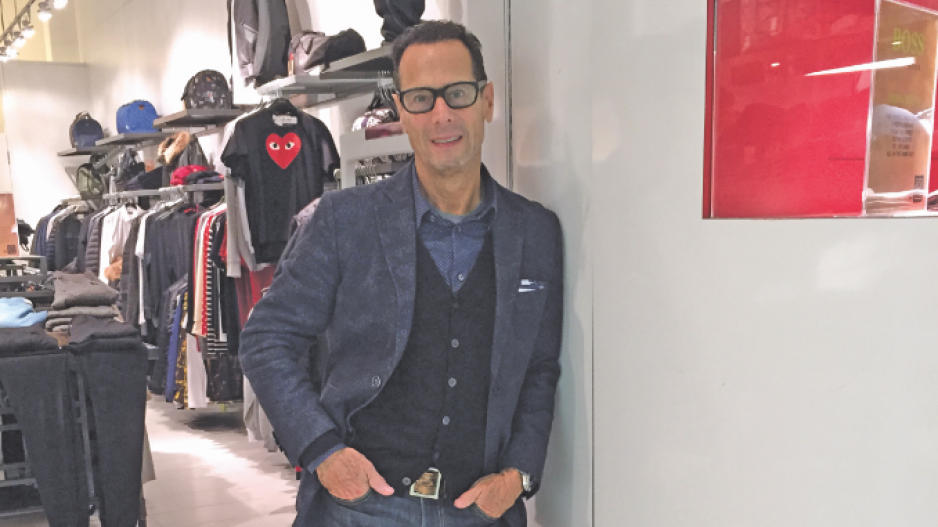Boys’ Co. owner David Goldman believes the bad days are behind him. His four-store menswear chain has swung back into being profitable and is poised to expand sales and profit by venturing into e-commerce this spring.
That’s a far cry from where the 30-year-old business was in late 2010 and 2011, when the world was emerging from the worst economic downturn in decades.
“Things were starting to slide more than we were comfortable with, and we couldn’t see the light at the end of the tunnel,” Goldman said while being interviewed on stage at the recent Retail West 2014 conference in Vancouver.
“We certainly never sat around just hoping that the business got better. We tried different initiatives.”
Nothing, however, seemed to work for Goldman, who founded Boys’ Co. with one store at Oakridge Centre in an era when far fewer competitors were fighting for market share.
So, to reverse what seemed to be an inexorable slide, Goldman called on David Gray, a longtime friend, retail consultant and DIG360 Consulting Ltd. principal.
It was an example of Goldman following the age-old small-business adage to work on his business, not simply at his business.
Gray helped Goldman identify who Boys’ Co. customers are and to segment the company’s customer demographics into groups: high school students, fashionable 20-something men, ethnic minorities and married guys who were in their 30s or older.
“We cater to all those groups, but we had to identify them and see what their lifestyles were and what the economy was for each of those groups,” said Goldman, whose family’s roots selling menswear in Vancouver stretch back to father Murray Goldman, who opened his first store in 1946.
His next step was to engage employees by having Mindfield Group ask them a series of questions in a confidential questionnaire.
Having a third party manage that process gave employees a sense that their comments would be taken seriously and that their motivations would not be prejudged.
“David [Goldman] understood that staff involvement in the transformation should start early and include a lot of contact along the way,” Gray told Business in Vancouver. “The employees had to be part of the shift.”
Engaging staff not only gave Goldman a better sense of who his customers are but also helped strengthen relationships with employees.
One example of Goldman showing trust in his staff is his allowing them, for example, to do things such as give a free item to returning customers when they make a large purchase. He said employees now feel empowered to do things like that without even telling him first.
Employees, Goldman reminded himself, are one of the most important of what he calls the brand’s “touch-points” with customers.
The Boys’ Co. transformation included identifying many of these so-called touch-points.
“If a customer comes in and he has a bad experience with the greeting or if he doesn’t like the window display or he doesn’t like the way the merchandise is laid out or if the music isn’t quite right – all of those things speak to the customer experience.”
Goldman added that he contracted Vancouver’s Music Direction to provide a computerized music system that streams music but allows staff both to change the music and to give it a thumbs-up or thumbs-down to automatically heighten some songs’ rotation.
“I don’t want to say that the product is just another touch-point, because it’s probably the most important one. Still, if the other ones aren’t spot-on, then the product is secondary,” Goldman said.
One tweak to his product mix, to help increase profit, was to create his own house brand – one that he would rather not reveal.
That brand hangs alongside brands such as Hugo Boss, Versace and Boy London and, because it is exclusively sold at Boys’ Co. stores, has a cachet and can command a price above entry-level brands.
Another of Goldman’s moves was to hire branding experts at Vancouver’s Juice Group to manage touch-points and ensure that the way the Boys’ Co. brand is presented is consistent throughout everything from window displays to print advertising.
Technology investments included traffic-counters, which are devices that shine infrared light across the door to track customer counts and provide Goldman a glimpse of when traffic is heaviest.
Edmonton-based HeadCount’s system does not give an exact count, he said, because two people who enter at the same time could count as one. But the result is usually at least 90% accurate.
Using both traffic-counters and point-of-sale terminals, he has been able to determine how much traffic is converted into paying customers and how many items the average customer buys at different times of the day, week and year.
That can help him provide incentives to staff. They know that if they are able to increase the average number of units purchased per customer to 1.8 compared with an average of 1.5 on a Wednesday in November, for example, they will be eligible for a bonus or extra perk.
No new stores are on the horizon, although Goldman plans to roll out e-commerce this spring.
“Doing e-commerce is not an easy task, and it’s a big investment,” Goldman said. “We’re looking at it as being another store. Will it be 1%, 2%, 10% of our sales? We don’t know yet. We’ll be happy with 1% and then see what we can get up to.”




